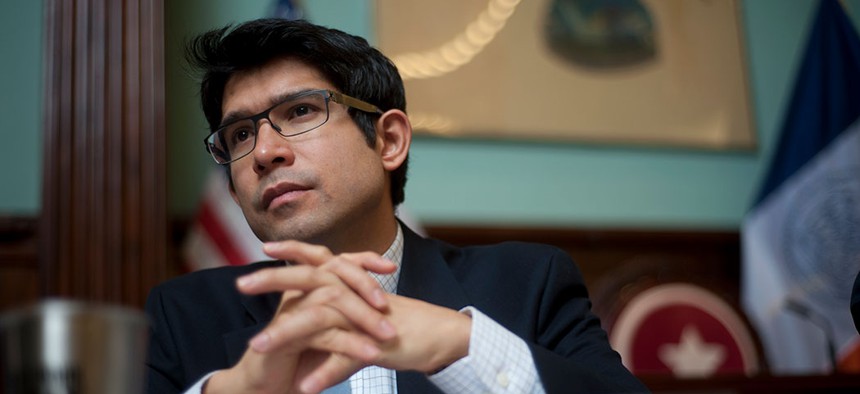On Monday, 34 of the New York City Council’s 51 members signed a letter calling for the U.S. Office of Personnel Management to allow for the hiring of noncitizens as temporary workers to assist with community outreach during the 2020 census. The letter was organized by City Council Members Carlos Menchaca and Carlina Rivera, who co-chair the Council’s Census 2020 Task Force.
Councilmembers fear that President Donald Trump’s anti-immigration rhetoric and the recently struck-down threat of a question about one’s citizenship on the census could cause a severe undercount of New York City’s estimated 3.1 million immigrants.
Although the U.S. Census Bureau has already been looking into allowing for non-citizens who reside in the country legally to be hired as temporary census workers, the letter hopes to push for the Office of Personnel Management, who have the final say in the matter, to allow for the bureau to do so.
Addressed to Dale Cabaniss, the director of the U.S. Office of Personnel Management, the letter says, “both the Bush and Obama administrations recognized the need to hire non-citizens for decennial census operations and allowed noncitizen hiring in the 2000 and 2010 censuses.” Although Bill Clinton was president when the 2000 Census took place – and it was not President George W. Bush, as the letter implies – it is true that the 2000 and 2010 censuses used noncitizen employees.
Typically, noncitizens are prohibited from working for the federal government by the Annual Appropriations Act. The act has a few exceptions, however, one of which includes the ability to hire noncitizens as temporary translators. Working within this framework, leading up to the 2000 Census, in an “unprecedented” act under the Clinton Administration, the U.S. Census Bureau revised its policy to allow for noncitizens to work as temporary census workers.
“For the first time our policy will be, if you are eligible to work in the United States, you are eligible to work on the U.S. Census,” said Bill Baron, then the deputy director for the Census Bureau in Washington, D.C., reported the Los Angeles Times in July, 1999.
Again, in 2010, the U.S. Census Bureau allowed for the hiring of noncitizens, but only 3,487 people out of the 500,000 total temporary workers hired were noncitizens. Tim Olson, the associate director for field operations at the Census Bureau, cited the large applicant pool of 3.9 million people, likely a result of the nation’s high unemployment following the 2008 financial crisis, as the reason behind why it wasn’t necessary at the time to hire more noncitizens, reported U.S. News and World Report.
With unemployment levels today at a low of 3.9 percent, a concern expressed in the letter is that with fewer people seeking work, there will be fewer applicants, which may result in a greater need for census workers who speak multiple languages and who belong to immigrant communities where census responses are already expected to be lower.
In New York City alone, there is a need for at least 40,000 people to work as enumerators for the 2020 census, according to the letter.
With over 400 languages spoken in the United States, there is some obvious potential need for legal immigrants to fill some of the slots for which census workers may need to be bilingual. Besides that, Anthony Chiarito, the Director of Communications for City Council Member Carlos Menchaca, says that in New York City specifically it’s important for people living in immigrant communities, many of whom are already wary respond to the census, that the people reaching out for responses are people from their own community.
Council District 38, which Mechaca represents, encompasses Sunset Park, Red Hook, Greenwood Heights, and portions of other Brooklyn neighborhoods. As one of the most immigrant-heavy areas of New York City, it is also one of the communities that would be most affected by an undercount during the 2020 Census.
Recognizing that the proposed addition of a citizenship question to the 2020 Census has been struck down, Chiarito says that the “chilling effect” of the proposal is still being felt amongst immigrant communities.
Jeremy Unger, the Communications Director for City Councilwoman Carlina Rivera, who represents District 2 on the East Side of Manhattan agrees. “The attempts of the Trump administration to include a citizenship question on the census that was rejected, you know, all these things, even when they're not successful continue to promote this culture of fear amongst certain immigrant communities,” says Unger.
The drawbacks of underreporting are felt most by low-income communities because census numbers determine how federal funds are dispersed. With fewer funds being directed to immigrant-heavy states like New York, social programs such as Medicare, food stamps, Section 8 housing vouchers and the National School Lunch Program would be underfunded.
Even with noncitizens having played a part in community outreach during the 2010 Census, an estimated 1 million children four years-old and younger still went uncounted in the U.S.
At the moment, the U.S. Office of Personnel Management has yet to respond to the letter, but Unger says that regardless of what happens, the fight against undercounting is far from over. “It's going to be really important for us, regardless of what happens, to make sure we're supporting community based organizations and people who have direct ties to these communities so that they can go out into those communities and explain to them the importance of filling out the census form.”
NEXT STORY: Andy King’s checkered past


